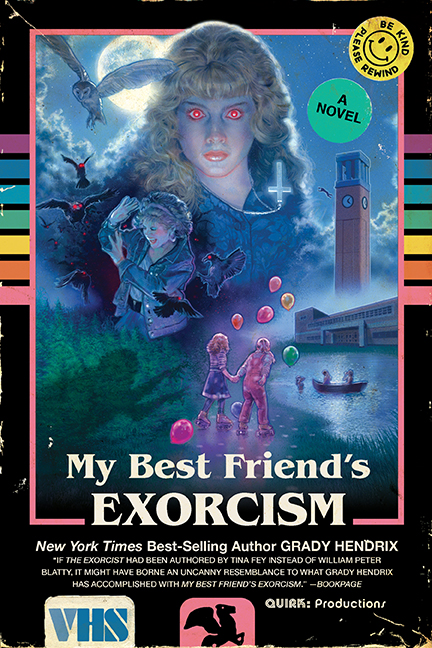Our Blog
Weirdest Shakespeare Adaptations Ever Made
Around the world, Shakespearean theaters are celebrating the birth date (and possibly death date) of the most famous playwright in history. Whether you love the Bard’s works, like we do, or don’t get what all the fuss is about, it’s hard to deny how influential Billy Shakes has been on pretty much every author to come after him. Beloved movies like 10 Things I Hate About You, She’s the Man, the Lion King, and West Side Story wouldn’t have existed without Shakespeare’s The Taming of the Shrew, Twelfth Night, Hamlet, and Romeo and Juliet, respectively.
But you know about those movies, right? We’re gonna get a little obscure, a little weird, and a little silly with these six bizarre adaptations of Shakespeare’s work.
Posted by Elizabeth Ballou
Best Literary References in the Mass Effect Series
[Developed by BioWare and published by Electronic Arts]
If you’re at all plugged into the video game world, you probably know that the next installment in the Mass Effect series, Mass Effect: Andromeda, is finally coming out today, March 21st. We can’t be more excited – what’s better than the next chapter in a gorgeously-written space opera? (Seriously, the plotting and dialogue is so good that some of us still aren’t over the emotional arrow to the knee that was Mass Effect 3…) But even better for us bookworms, the writers and developers at Bioware like to toss the occasional literary send-up into the games’ settings, lore, and witty wordplay. In celebration of Mass Effect: Andromeda, here are some of our favorite references from games 1-3.
Posted by Elizabeth Ballou
8 Fictional Realities Imagined As Oculus Rift Games
When I was a kid, all I wanted was to be able to step through the pages of my favorite book into the world its words described. A common fantasy, right? But now that virtual reality devices are hitting the mainstream market, my dream isn’t so farfetched any more. VR headsets will be on sale in time for the holidays, which made us at Quirk wonder…what would it be like if someone made games featuring our favorite fictional realities?
Posted by Elizabeth Ballou
Miss Peregrine DIY Hair and Makeup
[Still from Miss Peregrine's Home for Peculiar Children, 20th Century Fox]]
As you may imagine, we at Quirk Books have been struck by Peculiar Fever since the movie adaptation of Ransom Riggs’s Miss Peregrine’s Home for Peculiar Children came out. But when I saw the movie, I was focused on more than just the story: I couldn’t get enough of Miss Peregrine’s look. The steely blue hair! The perfect eyeliner! The sculpted curls! I knew I had to try the look myself, especially since Halloween is coming up. After some experimentation on my patient roommate, Priya, may I suggest that an Alma Peregrine Halloween costume is just the ticket?
Read the tutorial below to learn how to achieve Miss Peregrine’s style!
Posted by Elizabeth Ballou
How to Make a Potted Shakespeare Garden
[Photo by JD Mason on Unsplash]
If you’re a fan of the Bard, you’ve probably come across plenty of Shakespeare-related paraphernalia in your life: Shakespeare mugs, Shakespeare finger puppets, Shakespeare cocktails… the list goes on. But have you gotten a chance to stroll through a Shakespeare garden? From the Bard’s birthplace in Stratford-on-Avon to Cleveland to Central Park, gardeners have crafted beds of flowers and herbs that contain plants mentioned in Shakespeare’s works. And he mentioned them often, as in Friar Laurence’s famous monologue in Romeo and Juliet:
“O, mickle* is the powerful grace that lies
In herbs, plants, stones, and their true qualities…”
Act II, Scene III)
*great
If I had a big enough plot of land, I’d plant my own Shakespeare garden full of wild thyme (A Midsummer Night’s Dream), marigolds (The Winter’s Tale), honeysuckle (Much Ado About Nothing), myrtle (Antony and Cleopatra), daisies (Hamlet), and roses (pretty much every play). But my tiny Philadelphia patio is crowded by a few chairs as is. I can barely fit a grill out there, much less a garden. So what’s an urban Shakespeare fan to do?
Make a potted garden, of course! This method of garden-growing is perfect for city-dwellers and college students alike. Keep your pots by the window to watch your Shakespeare garden flourish.
YOU WILL NEED:
- plants of your choosing
- small terra cotta pots for each herb you pick; medium pots for every other plant
- drainage dishes for each pot
- potting soil
- acrylic paint (white or pastel for background; assorted colors for detail work) OR
- spray paint, lace fabric, and tape
- large paintbrush
- small paintbrushes
- felt-tip pen (black or metallic)
- clear acrylic sealer
Pick your Plants
The first step: choosing the plants you’ll feature in your portable garden. Stick with easy-to-grow herbs, like lavender, thyme, rosemary, and parsley; or go with flowers that are well-suited to indoor life, like violets, lilies, and even roses. Ivy is another good choice. Browse your favorite plays and sonnets for horticultural inspiration.
I wanted herbs I could use in the kitchen, so I visited the farmers’ market down the street from Quirk Books. There, I bought lavender, mint, and rosemary from Lunaria Gardens, a local permaculture nursery. Shakespeare would have approved of buying local, I think…not that he could have called up Home Depot and been like “Yo, I’ll have some of your roses damask’d, red and white,” you know?
Choose your Pot Design
Now it’s time to get as crafty as your little heart desire. After washing and drying your terra cotta pots, give them several coats of light-colored acrylic paint. Any color works, but you want to be able to read black text on top of it. Make sure you also paint a few inches on the inside so that the dirt will cover the paint line.

You can leave the pots as they are or decorate them with a design. I recommend polka dots, since you can’t mess them up (smudge your paint? Make a bigger dot! You meant to do that!), but you can also try stripes, chevrons, flowers, sunbursts, or abstract patterns.
If you’re really feeling ambitious, grab some lace fabric scraps and tape them to your pot. Spray-paint, aiming only at the sections covered with fabric. Untape and repeat until the entire pot is covered. You’ll get a gorgeous lace design!
I didn’t have any spray paint, so I went with gold, silver, and pastel purple mini-dots.

Write Down your Lines to Time
It ain’t a Shakespeare garden if you don’t make that clear on the pots! Look up the exact quote that includes the name of the plant you’ve picked. Don’t choose an entire soliloquy – you probably can’t fit that much (though mad props to you if you try). Just one or two lines – enough to give a little context – should do.

Take your felt-tip pen and practice writing the quote a few times. If you mess up, you can just cover your mistake with more paint – but it’s infinitely easier if you get things right the first time. Then pick a spot to write on. You can write along the rim of the pot or let your letters trail whimsically along the edges of your design – your choice.
Oh, and remember to include the play!

Seal Your Artwork
If you’ve been working indoors, this is when you should move outside. Your craft project won’t survive the next rainstorm unless you coat it in acrylic sealer…and trust me, sealer is not a smell you want stinking up your house.

Turn your pots upside down, shake your sealer can, and give every painted surface a thorough dusting. Pay extra attention to any letters. Wait a few minutes, then turn the pots right-side up and spray any paint on the inside. Wait again, then repeat the process. Two coats should be enough.
Repot Your Shakespearean Seedlings
Got gloves? Put them on now so that you can spread a light layer of potting soil on the bottom of each pot. (I did this sans gloves because I’m hardcore/cheap like that.) Then slide your fingers between the first seedling and the side of the container you bought it in. Gently wiggle it out and loosen the roots so that they’ll be able to spread. Place the root ball in the center of your pot, on top of the base layer of soil, and pack in enough soil around it so that the plant sits evenly. You can press down with your fingers to make sure that the soil isn’t loose.

Now that you’ve successfully repotted your plants, water them slowly and carefully, until the soil is damp to the touch and you can see water coming out the hole in the bottom.
Congratulations! You’ve created the first additions for your potted Shakespeare garden. No doubt Duke Senior, that champion outdoorsman from As You Like It, would approve:
“This our life…
Finds tongues in trees, books in the running brooks,
Sermons in stones, and good in everything.” (Act II, Scene I)

Reward yourself with a meditative cup of coffee or tea. Bonus points if you drink it out of a Shakespeare mug like this one. When you’re done, set your plants on the windowsill or anywhere they’ll get partial sun, and enjoy. If it’s warm where you are, you can keep them outdoors until the first frost. Add to your garden as you see fit.
“Here’s Flowers For You:” Gardening Tips and Tricks
I asked one of Quirk’s resident soil-tillers, Rick Chillot, to provide some advice for potted plant-growers. Here’s what he said:
- A pot that will fit on a windowsill is usually big enough for a single herb plant. If in doubt, go bigger. If you’re replanting something, you want a pot with enough space for the roots and room to spare. Use a pot that drains and put some pebbles at the bottom so the water will drain.
- Use a mix that’s labeled for container gardening or potting. Standard potting soil is fine; for bonus points mix it with some compost and perlite. Whatever you use, make sure it doesn’t have any additives, like fertilizers or nutrients or hormones or any kind of chemicals.
- Overwatering is generally more damaging than underwatering.
- Put the pots somewhere where you’ll see them often so you’ll be aware of any problems.
- Some herbs can grow for a while if you just set their roots in a glass of water.
Happy gardening, and let us know how your potted gardens turn out!
Posted by Elizabeth Ballou









